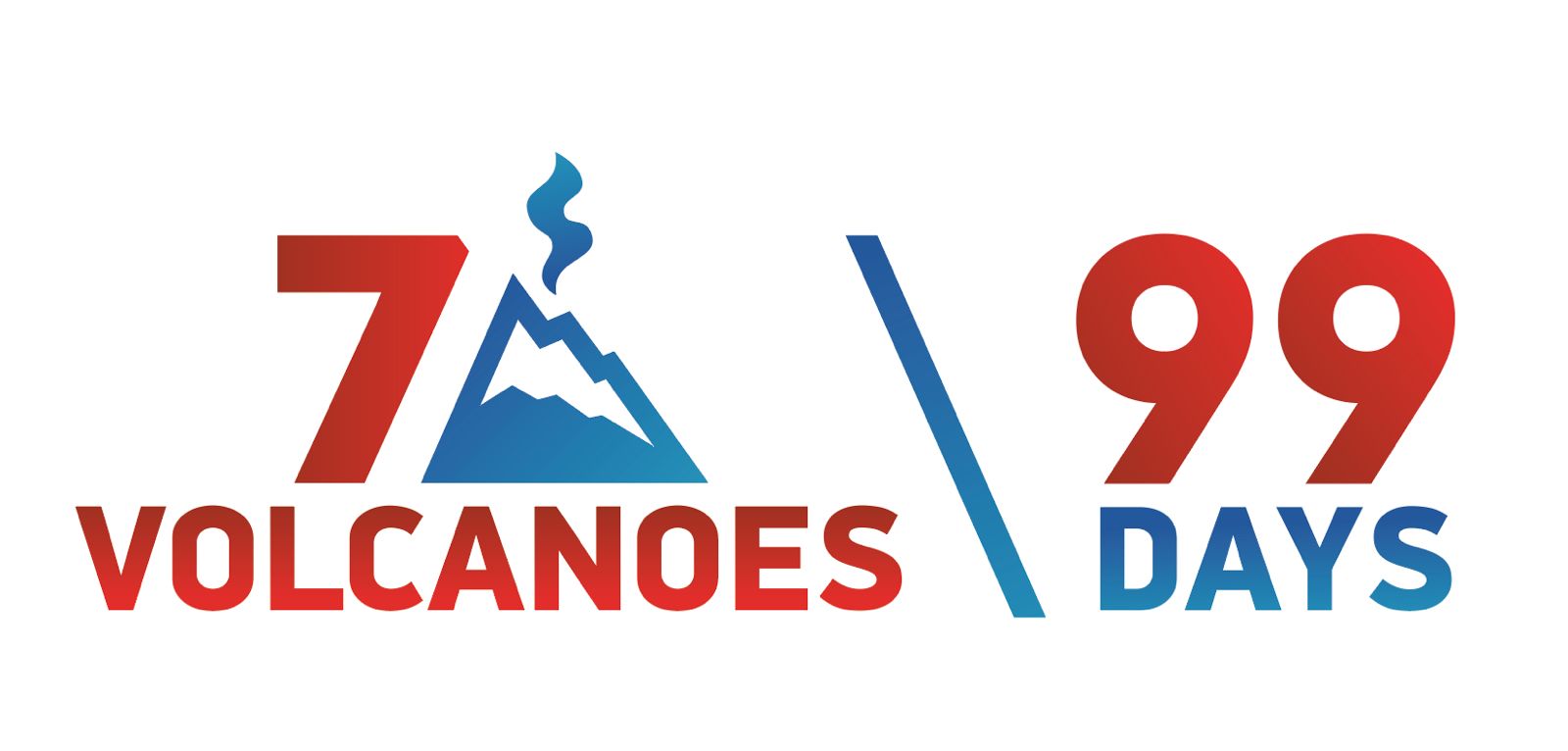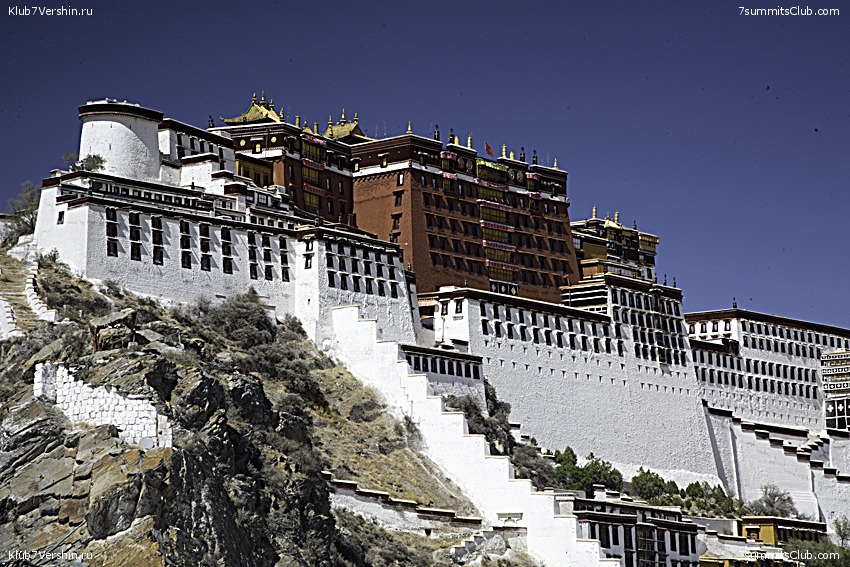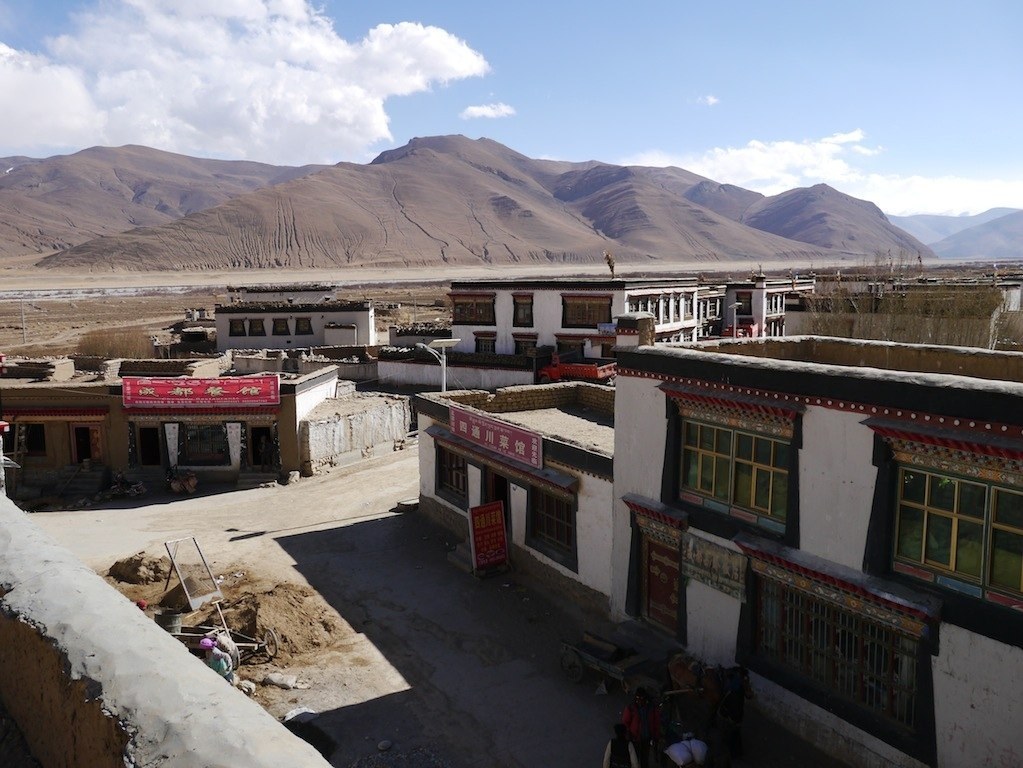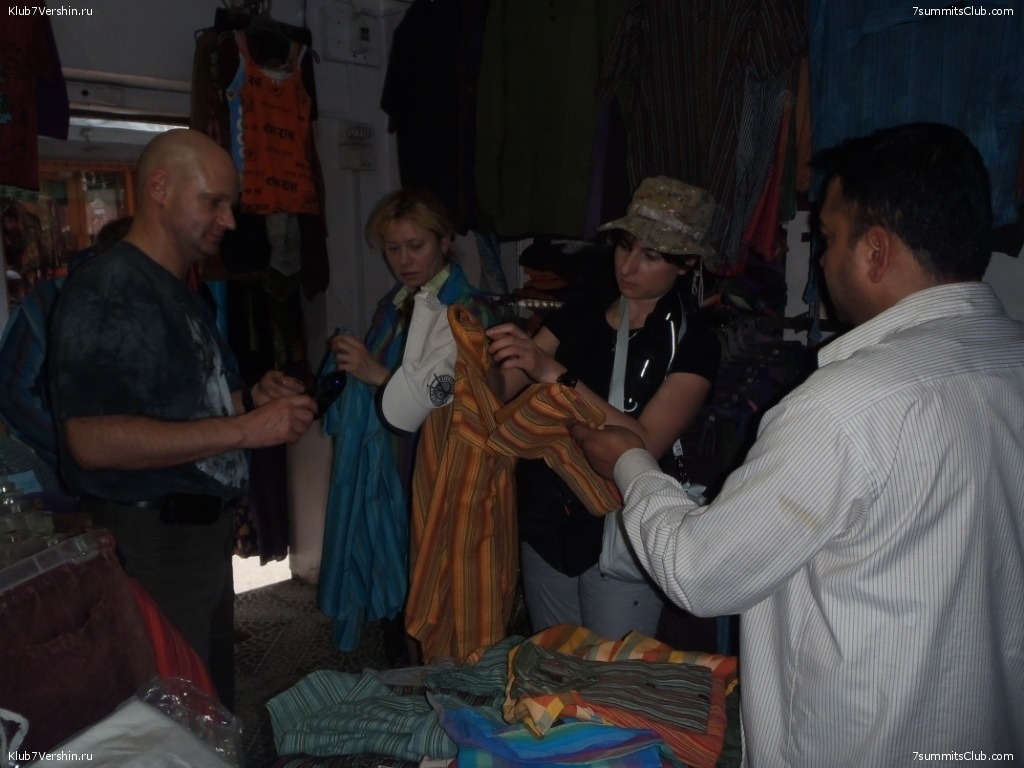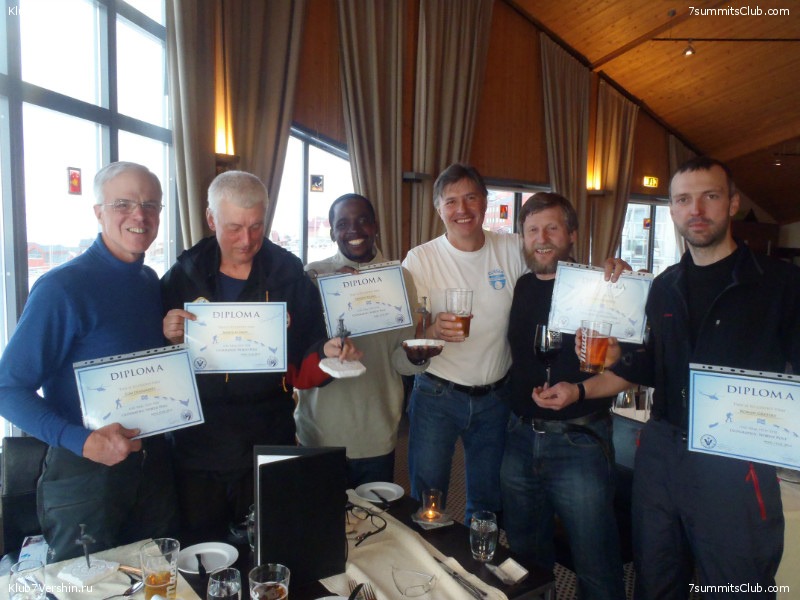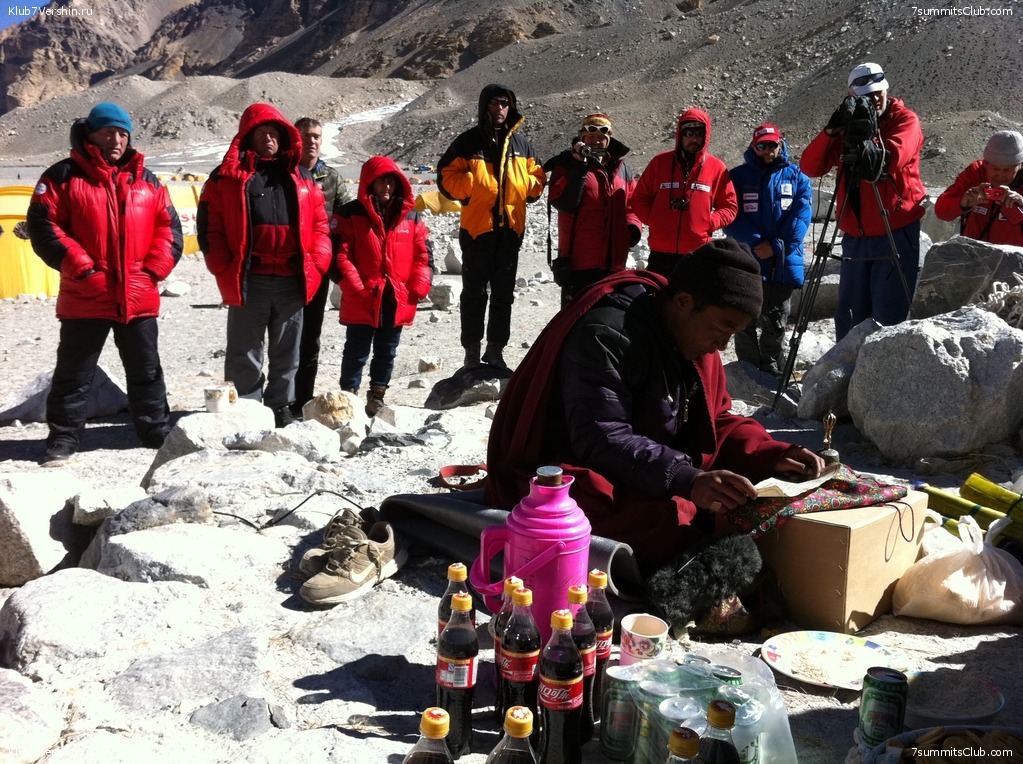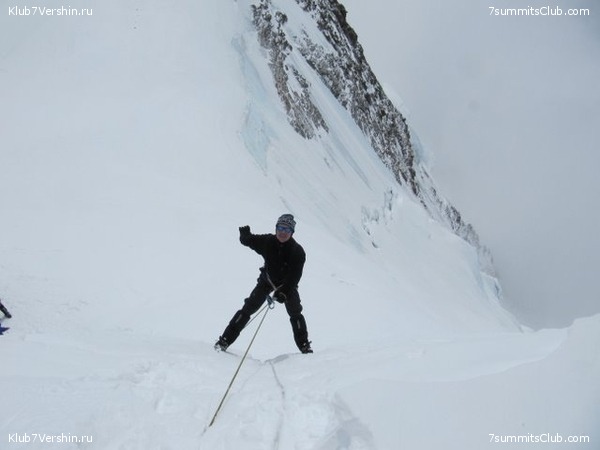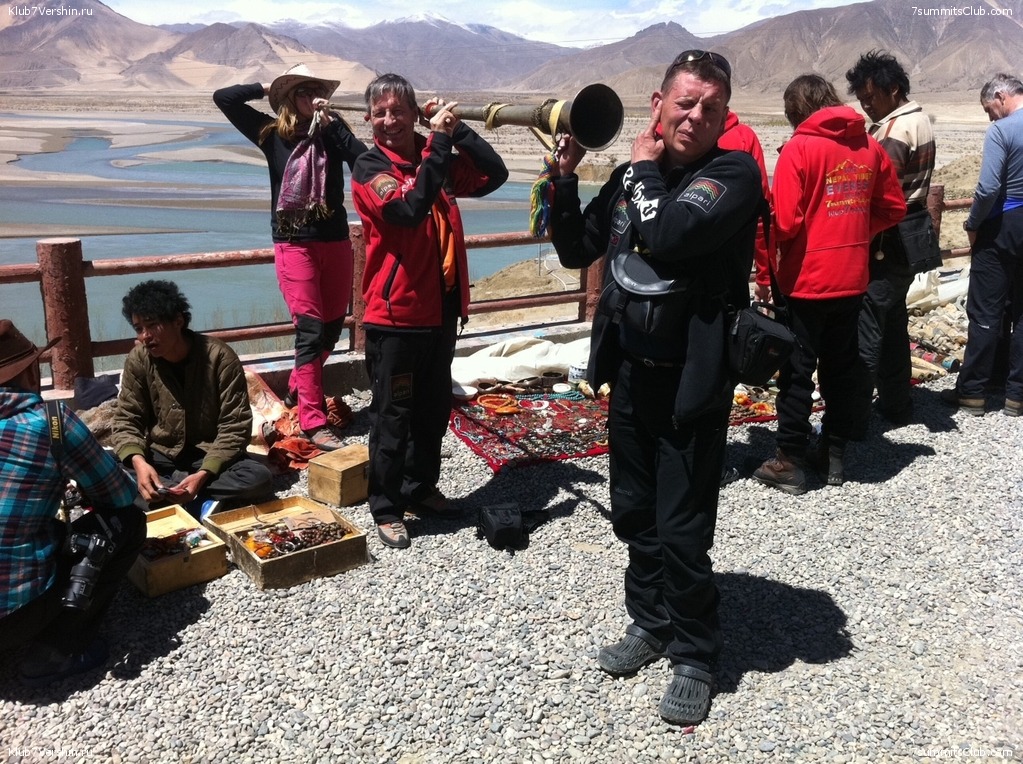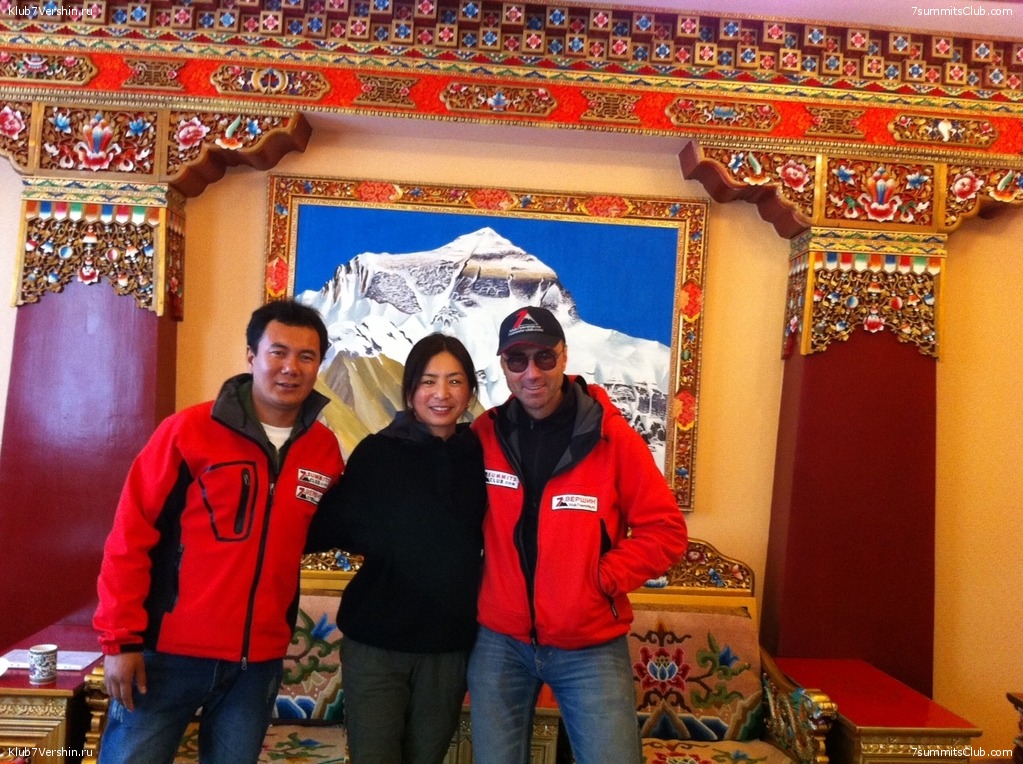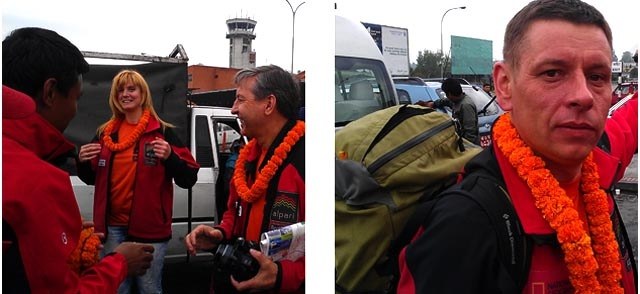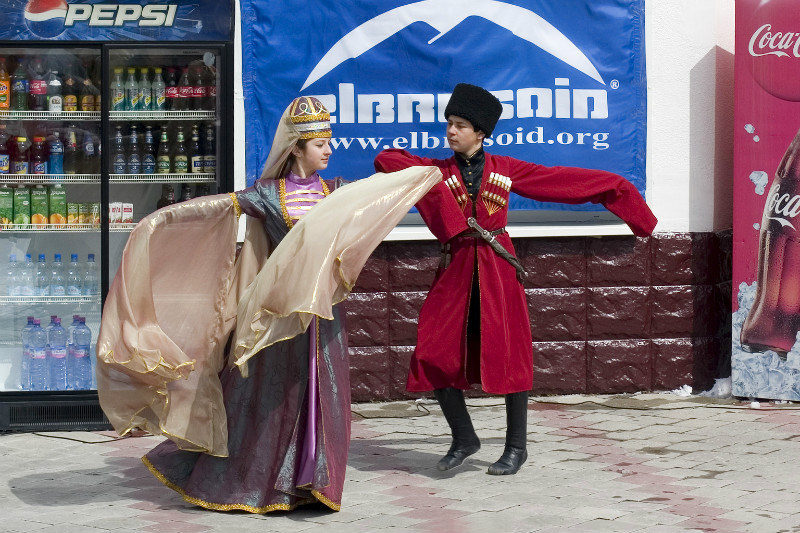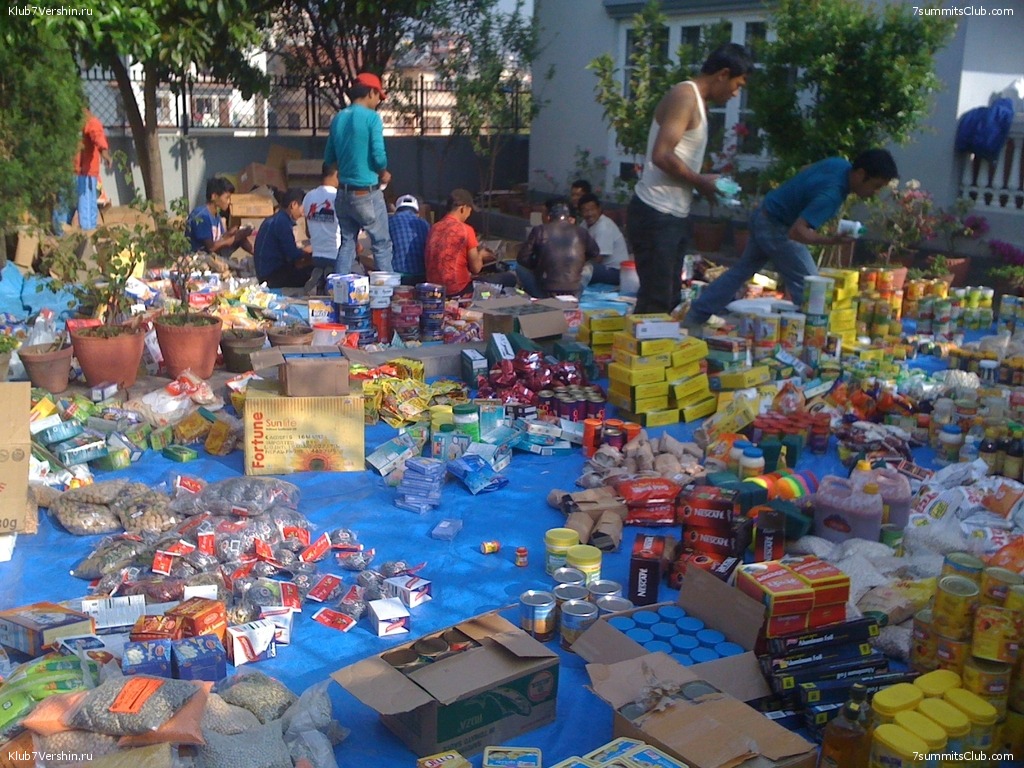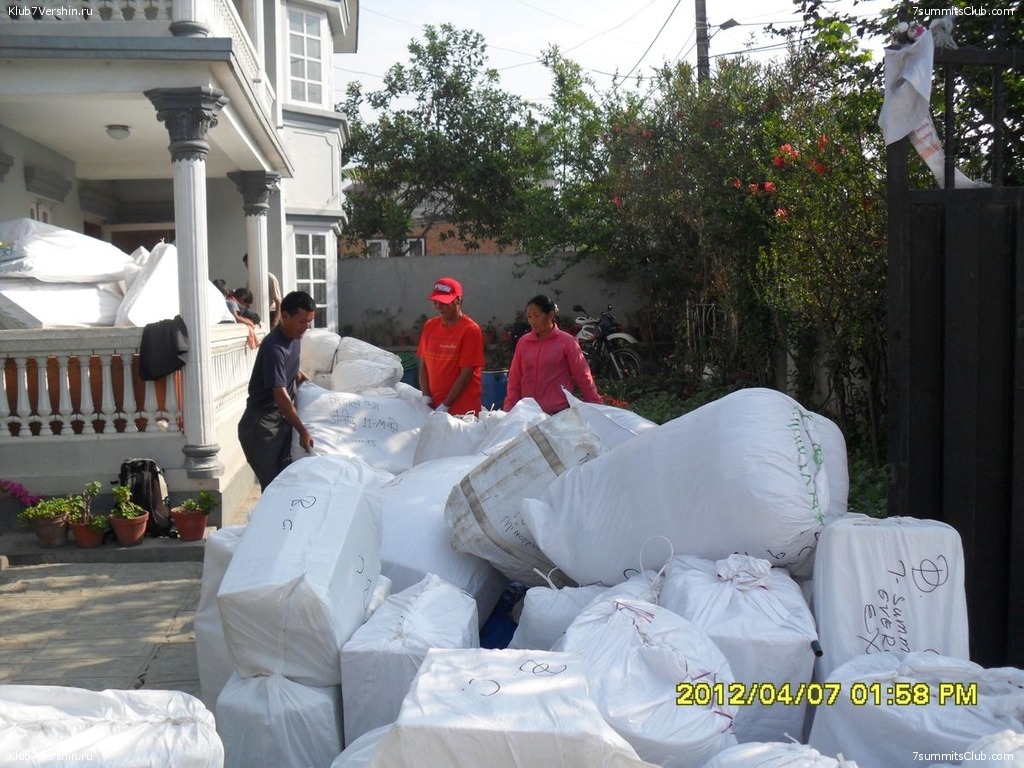All news: April 2012
Dmitry Ermakov from Lhasa
This is Dmitry Ermakov from Lhasa. Today, it is our second day in the capital ofTibet. Today we visited the Potala Palace of the Dalai Lama, made a walk through the city, visited the center of Tibetan medicine .. Tomorrow we go further ...
This is Dmitry Ermakov from Lhasa. Today, it is our second day in the capital ofTibet. Today we visited the Potala Palace of the Dalai Lama, made a walk through the city, visited the center of Tibetan medicine .. Tomorrow we go further along our route to Kailash, and will be in Shigatse. All participants feel good, everuthing is OK. Hello!
Alex Abramov from camp ABC: in a trap
Everest.
Hello! This is Alex Abramov from camp ABC. For three days we are in the advanced base camp of Everest. Wind is very strong and, in general, such a trap it ...
Hello! This is Alex Abramov from camp ABC. For three days we are in the advanced base camp of Everest. Wind is very strong and, in general, such a trap it is. We will not go down, still we want to go to acclimatize to the North Col and Changtsze. Up, but, we could not go, because in the horizontal field before a beginning of steep slope at the North Col there is a real hurricane
Photo of the Alpari Team from alpari-life.ru
Digest and photos from Alex Abramov
It is Alex Abramov from Everest. A few days ago we went down to the base camp, and then our team went on vacation 50 kilometers below the base camp at 4200 meters altitude. There we rested well. We stayed two nights in Tashidzhong, we ate ...
It is Alex Abramov from Everest. A few days ago we went down to the base camp, and then our team went on vacation 50 kilometers below the base camp at 4200 meters altitude. There we rested well. We stayed two nights in Tashidzhong, we ate mutton meat, useful for mental activity.
And finally, we reached the ABC camp at the height of 6400 meters. There are very strong wind, then we spent the past two days, two nights here ... Today, the second team comes from the bottom up.
Today our first team conducted studies on the natural ice. On the ice slopes we climbed up, then traverse across the ice, using ropes and went down. So a several times. It was quite useful.
Now on the North Col, where we're going to go to sleep, it is very strong wind. Half of the tent is broken. Our tents are all, because Sherpas have put them down in order to not break. Well we'll see. Well, until we have a plan to spend a night on theNorth Col.
Start of a new trekking program Around Annapurna
Today, April 28, a new our Nepal program began: Trekking aroundAnnapurna. During the day the members arrived in Kathmandu, where they were met by 7 Summits Club guide Olga Rumyantseva. Almost immediately from the plane all people went for a ...
Today, April 28, a new our Nepal program began: Trekking aroundAnnapurna. During the day the members arrived in Kathmandu, where they were met by 7 Summits Club guide Olga Rumyantseva. Almost immediately from the plane all people went for a walk on Tamel and buy a shirt for trekking. In the evening dinner will be arranged in a Nepalese restaurant. And tomorrow we will go towardsAnnapurna. Group members: Denis Nenakhov, Maria Nenakhova, Eugene Ganja, Alena Ganja, Maxim Gorbunov and Elena Gorbacheva.
On the way to Baruntse
April, 24 A team of 7 Summits Club Victor Bobok (guide) and Andrey Filkov flew to Nepal to climb Mount Baruntse 7129 mThe ascent is planned via the normal route - the Southeast Ridge. Baruntse of is located between Everest and Makalu ...
April, 24 A team of 7 Summits Club Victor Bobok (guide) and Andrey Filkov flew to Nepal to climb Mount Baruntse 7129 m
The ascent is planned via the normal route - the Southeast Ridge. Baruntse of is located between Everest and Makalu (8471m). The approach to base camp is a multi-day trekking. The nature of the route, mostly snow and ice. The steepness of the ice can reach 50 degrees. One steep step is above 7,000 meters. Route is avalanche dangerous after snowfall. In the spring, it is often equipped with fixed ropes. But it depends on the number of climbers who have subscribed to this program.
Photo from an exploration of a new route and other news from Everest
Everest.
Hello! This is Alex Abramov from Everest. We are now at an altitude of 6400 meters in advanced base camp. This is the first team. The second team is in the intermediate camp at 5800 meters. Weather, in general, it is not bad. The sun is ...
Hello! This is Alex Abramov from Everest. We are now at an altitude of 6400 meters in advanced base camp. This is the first team. The second team is in the intermediate camp at 5800 meters. Weather, in general, it is not bad. The sun is shining, however, the clouds in the afternoon. Today we made a reconnaissance, we want to make a new route across the top of Changtse ascent on Everest. Today we made an exploration ...
Roman Gretzky and Alexander Lozhkin reached the North Pole. PHOTOS
North Pole.
Members of the 7 Summits Club Roman Gretzky and Alexander Lozhkin on April 11th, reached the extreme northern point of our planet. They came on skis in the program Last Degree. It was the first group of the season. They sent us some ...
Members of the 7 Summits Club Roman Gretzky and Alexander Lozhkin on April 11th, reached the extreme northern point of our planet. They came on skis in the program Last Degree. It was the first group of the season. They sent us some photos from this unforgettable trip.
Puja is a one of the most important part of the expedition
Puja ceremony was held this morning. It was a prayer for the success of the expedition. Wind was blowing to the top - up the hill. So, it is time to go up. Now cooks prepare our traditional borshch (beet-root soap). The first group goes up ...
Puja ceremony was held this morning. It was a prayer for the success of the expedition. Wind was blowing to the top - up the hill. So, it is time to go up. Now cooks prepare our traditional borshch (beet-root soap). The first group goes up to an intermediate camp, and tomorrow to the Advance Base Camp at 6400m altitude. Today, Semion Deyak has to come back from Dzhangmu. We sent him down with symptoms of acute mountain sickness. We think it is all good now. Alex Abramov.
Start a new expedition to Nepal
Today, a large group of 7 Summits Club flies from Moscow to Kathmandu. They are members of the trek programs Everest Base camp and ascent of Island Peak. Guide of the 7 Summits Club Denis Saveliev rested after a heroic climb of Mera Peak ...
Today, a large group of 7 Summits Club flies from Moscow to Kathmandu. They are members of the trek programs Everest Base camp and ascent of Island Peak. Guide of the 7 Summits Club Denis Saveliev rested after a heroic climb of Mera Peak and is ready to meet the group.
List of the members.
Island peak:
Petryaev Alexander
Emelyanov, Elvira,
Lutikov Alexander
Aglitsky Constantine
Lerner Roman
Lerner Julia,
Moiseeva Lola.
Trek to Everest base camp:
Manizada Jamil,
Tinin Yuri
Kovalenko, Ruslan.
Good luck, good weather, a good trip!
Our expedition arrived at the base camp
Everest.
A trip to Tibet inevitably ends up arriving at the base camp. As the most exciting moment in which we remember the first sight of Everest, from the pass. Here, each participant would like to part with the old life and makes a decisive step ...
A trip to Tibet inevitably ends up arriving at the base camp. As the most exciting moment in which we remember the first sight of Everest, from the pass. Here, each participant would like to part with the old life and makes a decisive step into the future.
Ludmila Korobeshko from Xegar (4200)
Everest.
Today there was a lot of things "at first" First, we made the first serious acclimatization climb. Hooray! Shegar Dzong was climbed to the top (4800 m). This mountain name is translated as Fortress Xegar and it is very unusual. At ...
Today there was a lot of things "at first"
First, we made the first serious acclimatization climb. Hooray! Shegar Dzong was climbed to the top (4800 m). This mountain name is translated as Fortress Xegar and it is very unusual. At its base there is an ancient Buddhist monastery school gelukpa - Xegar. And on the top we met a stupa and prayer flags. The last few tens of meters to go the top led by a very steep scree slope. And from the top we have a stunning view of the Himalayan mountain range and on ...
Yes, yes - this is the second "first" ... we saw Mount Everest. The majestic pyramid with a huge white flag. Probably a strong wind blows the snow off the slopes.
We hope that to the time of our climb the storm will be over.
Tomorrow we go to the base camp of Everest. That is, tomorrow we'll spend the night in 5100. With headaches of course, what would be a good for acclimatization.
Team of Denis Saveliev climbed Mera Peak
We are in Lukla. Tired and satisfied by the work done. The guys still do not believe that we were able to climb to the summit of Mera Peak. For all of the expedition has not issued a single day to the sky that it is not raining or pouring. ...
We are in Lukla. Tired and satisfied by the work done. The guys still do not believe that we were able to climb to the summit of Mera Peak. For all of the expedition has not issued a single day to the sky that it is not raining or pouring. Numerous teams coming down to meet us is not getting to the top does not inspire optimism and undermine confidence in the success of their stories, why they failed. Especially liked the story about the new crack width all of the slope and length of 2 meters, which can only be overcome only with the help of aluminum ladders.
As a result, we have been to the camp at 5800m. On the climb we were out as scheduled at 3 a.m.. The sky was cloudless, only the stars and the moon. But our joy was not long. Just a couple of hours everything was clouded, the wind rose and it began to snow. We reached that big crack. It turned out not so scary. We easy found a bridge and crossed it.
Vlad Lachkarev was the first on the top at 10:30, breaking the 30 - meter vertical wall on fixed ropes. Here, åðó nature took pity on us and opened up a half hour panorama of the Himalayas - Everest, Lhotse, Makalu and other big mountains can be seen from the peak.
The way back to the camp was not easy. We were forced to stray among the cracks, because the visibility was about zero. The old tracks were covered with snow. Each one of us fell into a crevasse about three times.
On that day, our team was alone on the top. All groups canceled one after another, what is especially valuable to us.
Arkhyz: ski resort with a past gets a reset. VIDEO
Elbrus.
Vsevolod Pulya. The first chair lift and two trails opened March 18 in the North Caucasus resort of Arkhyz. Alexander Khloponin, presidential envoy to the North Caucasus Federal District, was the first skier to come down the slopes. In a ...
Vsevolod Pulya. The first chair lift and two trails opened March 18 in the North Caucasus resort of Arkhyz. Alexander Khloponin, presidential envoy to the North Caucasus Federal District, was the first skier to come down the slopes. In a celebratory speech afterwards, he noted that while this was certainly a signal event, “there is still much more to do.”
Jam made from pine cones, Cossack fur hats, mountain herbs for tea drinking, sweet homemade wine: these are the sorts of souvenirs tourists bring back from Arkhyz. At local stands they can also buy refrigerator magnets showing snowboarders and skiers against dramatic mountain backdrops. In reality, however, there aren’t any ordinary skiers on the slopes yet. Construction of the Arkhyz Resort has only just begun: instead of hotels there are improvised camp sites, there is almost no cell phone coverage, and there was no point paving the 8.5 miles road to the resort ahead of Sunday’s opening since the heavy construction trucks would destroy it in a matter of weeks.
Before the construction began, the only people who came here in winter were extreme skiers with plenty of money – or at least enough to hire a helicopter to drop them at the top of Arkhyz’s virgin trails. In the summer, mountain biking and rock climbing without the necessary infrastructure attracted only the daredevils.
But Arkhyz, which gets some name recognition from a widely distributed mineral water of the same name, is a resort with prospects. In the local dialect, Arkhyz means “beautiful girl,” and a glance at the landscape is enough to see why. Arkhyz is also in a very convenient location: less than four hours by air from most countries in Europe, Asia and the Middle East. The nearest international airport, in Mineralye Vody, is only 125 miles away; the region also plans to build some smaller airports for private planes.
A Russian Les Arcs
Many of those who attended the opening ceremony at Arkhyz sported hats and scarves bearing the Latin words per angusta ad augusta, which means “through ravines to the heights.” The real heights at Arkhyz are still to be scaled. The new four-seat chairlift takes skiers up only 377 feet, to an altitude of 5,800 feet; the resort itself sits at an altitude of 5,400 feet above sea level. The first two trails are 2,200 and 3,600 feet long. The next stage — construction of five hotel complexes with 700 rooms – will be completed by this fall, in time for the start of the new ski season. By then, the combined length of open ski trails will be almost four miles. These figures may seem modest to inveterate downhill skiers, but these are just trial balloons. Arkhyz has more ambitious plans. “The real work on this resort will begin at the end of the year when we propose specific sites to investors,” Khloponin declared at a post-ski press conference.
Related :
The Caucasus – Ancient traditions and a complex history
Fighting terrorism with tourism
Time to remember, heal and build a good name
The builders say that when it’s finished, Arkhyz will be comparable to Les Arcs, the French ski resort in the Alps. All told, eight years from now, Arkhyz will consist of four tourist complexes housing a total of 24,000 guests; 54 ski lifts able to carry 45,000 skiers a day; ànd ski trails totaling 167 milres in length. All of this will be available with a single ski pass. At Resorts of the North Caucasus (KSK), the company in charge of developing the tourist cluster in the North Caucasus, specialists say that once Arkhyz is finished and in full operation, it should draw more than half a million skiers a year.
The first goal of the resort is to make downhill skiing affordable for averages Russians. “Resorts in the North Caucasus cluster should not compete among themselves,” said Alexei Nevsky, general director of KSK. “We have to develop a single concept, a single marketing and price policy.”
This project also has a social mission: it will create 10,000 jobs in the Republic of Karacheyvo-Cherkessia, according president of the republic Rashid Temrezov. At any rate, local grandmothers are ready to take in guests: their homemade meat pies and wool socks are already selling well.
Nature and history
Facts and figures
1,440 and 3,300 meters (4,700 feet-10,800 feet) above sea level is the difference in altitudes in Arkhyz Valley. The highest points: Mt. Pshish and Mt. Sophia
60 glaciers and mountain lakes are located in the valley
12 waterfalls crash down from the Sophia Glacier
170 km (105 miles) is the length of the resort’s main waterway: the Zelenchuk River
+14.8 Celsius (58 Farenheit) is the average air temperature in summer
- 5.6 Celsius (21 Farenheit) is the average temperature in winter
0,5-2,5 meters (18 inches-8 feet) is the average thickness of the snow cover
The Arkhyz Gorge is protected from strong winds and blessed with a mild climate. Its alpine slopes are covered with dense stands of fir trees and pine trees and it is the home of 26 natural mineral springs.
Meanwhile, for non-skiing tourists or those who want a break from the slopes, there are some unique local excursions. A mysterious natural icon of Christ is carved right on the steep left bank of the Zelenchuk River. Christ’s face looks down on ancient churches and the remains of the ruined city of Maas. The oldest of the churches was built 1,200 years ago, making it the most ancient religious edifice in Russia.
Thirty-seven miles to the west of Arkhyz is Adyukh Mountain, which has a small tower on its summit. The mountain and its fortress were named in honor of a girl who, as legend has it, was so unhappy in love that she threw herself off the mountain top; another legend claims that she threw off the rope ladder on which her unfaithful lover, a horse thief, was climbing. Visitors able to climb the 730 steps up to the top will be rewarded with a magnificent view of the Zelenchuk River and surrounding valley — the horizon stretches away to Abkhazia.
At the foot of Mt. Adyukh is the Adyukh Palace Hotel, whose owner is a veteran collector of antique automobiles. His collection includes a 1950s Mercedes, and old UAZ that has not driven even one mile in all its 40 years of existence, and a complete collection of Volgas, Chaikas and ZIMs.
A new cluster
The Legend of Caucasus - watch video
Arkhyz is KSK’s debut project. By 2020, KSK plans to have fully developed this tourist cluster with world-class ski resorts throughout the North Caucasus. Meanwhile, Dagestan’s Caspian Sea coast will be dotted with beach resorts. When construction of the cluster is complete, it will boast a combined total of 680 miles of downhill ski trails and 227 ski lifts, as well as hotels, apartments and cottages for 102,500 people.
Northern Caucasus resorts map + info. Click to view infographics
KSK anticipates that this cluster will receive between 5 and 10 million vacationers every year. The total volume of federal investment in the transport infrastructure and communications of resorts in the North Caucasus should equal 60 billion rubles ($20 billion). The Sinara Group, an investor in and builder of Arkhyz, put up 1 billion of the 3 billion rubles already spent on building the resort and its infrastructure. The project’s financing is being conducted on the principles of a government-private partnership. The project will receive a total of 80 billion rubles ($2.7 billion) in investment.
These Russian investors are expected be followed by foreign investors; investors from France and South Korea have already signed agreements on a joint enterprise, according to Nevsky. He confirmed that the South Korean company Korea Western Power is ready to invest $1 billion in the cluster’s electricity supply network, while the investment bank Singapore Nexus means to invest in the development of hotels.
Our expedition passed through Shigatse to Xegar
Everest.
The Everest expedition 7 Summits Club Everest meets the Easter holidays in the heart of Tibet. We spent a day in the city of Shigatse (3900m). It was very successful day. Nice sunny weather favored sightseeing tour, acclimatization, food ...
The Everest expedition 7 Summits Club Everest meets the Easter holidays in the heart of Tibet. We spent a day in the city of Shigatse (3900m). It was very successful day. Nice sunny weather favored sightseeing tour, acclimatization, food intake and religious reflection on the eve of Easter. Next stop is Xegar (4200m).
Happy Day in Lhasa
Everest.
Today the Everest team of the 7 Summits Club visited the Potala, the former palace of the Dalai Lama. All members were delighted. We note a good attitude, hospitality of Tibetans.Everything in this country seems unusual. Even the World Map ...
Today the Everest team of the 7 Summits Club visited the Potala, the former palace of the Dalai Lama. All members were delighted. We note a good attitude, hospitality of Tibetans.Everything in this country seems unusual. Even the World Map they have unusual ....
Alex Abramov and Mingma (Director 7 Summits Adventures) visited the STMA - Tibet Climbers Alliance, which organizes our Everest expedition. We met with the chairman of the STMA Mr. Chang. And the manager, whose name is Tsedron. The meeting was held in a friendly atmosphere.
Roman Gretzky and Alexander Lozhkin reached the North Pole
North Pole.
According to our data, the members of the 7 Summits Club Roman Gretzky and Alexander Lozhkin on April 11th, reached the extreme northern point of our planet. They came on skis in the program Last Degree. It was the first group of the ...
According to our data, the members of the 7 Summits Club Roman Gretzky and Alexander Lozhkin on April 11th, reached the extreme northern point of our planet. They came on skis in the program Last Degree. It was the first group of the season. Yesterday they had already flown fromCamp Barneo on Svalbard. We do not know whether they were present at the next unique event ...
Barneo Camp
Borge Ousland married at the North Pole
(Text Explorersweb) Here's some celebrity news from the Barneo Ice Station: Veteran Norwegian polar explorer Borge Ousland just got married at the Geographic North Pole, according to Lutheran wedding custom, with a pastor, candles and a cross made of skies.
Borge was dressed in national Norwegian dress. The bride, Hege was dressed in a warm, long, white dress.
The couple flew in from Longyearbyen,Svalbardto Barneo Ice Station where they boarded the Russian MI-8 helicopter to the North Pole. The proceedings lasted 30 minutes. After the ceremony champagne was served together with a colorful fireworks display.
Just in time to find out what the noise was about,UKskier Mark Wood appeared behind the pressure ridges. During the Antarctic ski season Mark skied solo from Hercules Inlet to the South Pole (10 degrees of latitude) and now three months later, skied the last degree to the North Pole.
The weather on the wedding day at Barneo (N89° 36' and E007° 34') 44.5 miles from the Pole was: Temperature -23°C , north-westerly wind of 3 m/s, and the visibility excellent.
In 1994 Børge Ousland became the first person to ski solo from land to the North Pole. He did a kite-ski traverse of the Arctic Ocean from Russia to Canada via the North Pole as well as a kite-ski traverse of Antarctica, from Berkner Island to McMurdo. Ousland and Mike Horn attempted the North Pole in Winter, unassisted, unsupported, starting January 22, 2006 and arrived at the North Pole March 23, only two days after sunrise. Other expeditions by Borge are ski expeditions on the Southern and Northern Patagonia Icecaps and Frans Josef Land, as well as a sail expedition around the Arctic Circle.
Arrival in Kathmandu
Everest.
On April 10, after a sleepless night, our team finally landed in Kathmandu, the capital of Nepal. Our layover in Delhi turned into a battle with the representatives from Jet Air, who, after rummaging through our luggage, decided that we ...
On April 10, after a sleepless night, our team finally landed in Kathmandu, the capital of Nepal. Our layover in Delhi turned into a battle with the representatives from Jet Air, who, after rummaging through our luggage, decided that we were carrying dangerous cargo and told us that they couldn’t take our equipment any further. We told them about our expedition to Everest and explained how important that hardware is to us.
We finally got them to come around, but only after giving them our autographs and a couple of Alpari t-shirts (and showing their managers the site).
When we got into Kathmandu, we were met with a flurry of commotion, rickshaws and rain.
This evening we are going to unwind with a nice dinner. Tomorrow we’ll pack up our things. On April 12, we fly out to Lhasa, Tibet.
-Lyudmila Korobeshko
Five minutes after we got the message from our captain, Maxim called to describe the team’s emotional state. Not everything he told us is suitable for print, so we’ll leave you with a few choice excerpts: “unpleasant”, “over weight”, “couldn’t get any sleep”, “Dusharin has gingivitis”.
We hope a decent meal will help cheer you guys up.
Start the 10th (anniversary) Everest expedition of the 7 Summits Club
Tonight most of the 7 Summits Club expedition members took off from rainy Moscow in the direction of Nepal. According to the plan, tomorrow they should be solemnly met at the airport in Kathmandu. And on the 12th April we have tickets to ...
Tonight most of the 7 Summits Club expedition members took off from rainy Moscow in the direction of Nepal. According to the plan, tomorrow they should be solemnly met at the airport in Kathmandu. And on the 12th April we have tickets to the capital city of Tibet Lhasa. From there it begins the path to the base camp of Mount Everest on motor vehicles. The first group of Sherpas from our expedition had already gone to arrange the base camp.
Guides and members of the expedition:
Permit Everest:
Guides (4):
Expedition leader Alexander Abramov (48), Sergey Bogomolov (61), Noel Hanna (Ireland, 45), guide and doctor Sergei Larin (51).
Members (16):
Visa Yusupov (60), Leila Albogachieva (42), Aznor Khadzhiev (40), Vladimir Korenkov (56), Magomed Aushev (59) Musa Hadziev (57) - a team of Ingushetia.
Ludmila Korobeshko (37), Ivan Dusharin (64), Maxim Shakirov (44) - Team "Alpari on the tops of the world."
Berdychowski Zygmunt Wladyslaw (Poland, 51), Schneider Nathaniel Raymond (U.S. 33), Pratt III Joseph Hyde (U.S. 56)
Igor Kadochin (42), Cyrille Muraviev (40), Fyodor Konyukhov (60), Vladimir Zaitsev (58).
Permit Changse (North Peak of Mount Everest) - 2.
Semen Deyak (50), Sergei Schekoldin (56).
Trekking Permit - 3.
Marian Surunchap (50), Machuca Tomochkanov (37), Maadyr-ool Khovalyg (64) – Tuva Republic Team
Elbrus on the pages of Alpinist and in reality. Welcome !
Elbrus.
Winter season on Elbrus smoothly into spring and summer’s Winter leaves Elbrus. No full satisfaction, but it was not disappointed. Sometimes it was not enough snow. Sometimes it was felt that not everyone decided to come. Again, ...
Winter season on Elbrus smoothly into spring and summer’s
Winter leaves Elbrus. No full satisfaction, but it was not disappointed. Sometimes it was not enough snow. Sometimes it was felt that not everyone decided to come. Again, the terrible tragedy of climbers on Elbrus ... But there was a lot of good. There are a lot changes for the better. And in the safety order, and in lifts. Our favorite hotel Povorot was worked almost "at five". And we look forward with optimism of the summer. However, it is spring. And we are waiting for the May holidays, waiting for the competition Elbrus Race of the Red Fox. It is always a big event. And this year it will record number of participents.
Latest news:
Completed a series of festivals in the Elbrus region. Management has prepared the region this year, a lot of pleasant surprises for the tourists. From 25 to 31 March it was held contest for ethnic artAltyn Square with the participation of teams fromRussia and CIS countries. On March 31 the baton took Elbrus Festival 2012, sponsored by the well-known musicians from Moscow and St. Petersburg: Michael Bashakov, Yuri Garin, Michael Kalinkin, Arthur Gladyshev, Dmitry Yurkov, the band "Kings of the Kitchen." Did the weather. Sunny days were followed by heavy snowfalls, so that skiers have an excellent opportunity for the free ride on the Cheget, and to be ridden on groomed slopes of Elbrus. And in the evening all gathered at the "Povorot."
----------
http://www.alpinist.com/doc/web12s/wfeature-elbrus
Elbrus
Casey O'Malley Posted on: April 6, 2012
[Photo] Mt. Elbrus courtesy of Mountain Madness/Savejko Photo.
It has been over one year since Mount Elbrus (5642m), Europe's member of the seven summits, was targeted in a terrorist attack. On February 18, 2011, two unidentified men stopped a van carrying five Moscow tourists to the Elbrus area—the men opened fire on the passengers after claiming to be plainclothes policemen. Three of the passengers died; two were hospitalized. Later that day, a bomb damaged a support tower for a cable car that travels up the side of Mount Elbrus. Thirty of the forty-five cars were damaged, but no people suffered injuries. The next morning, Russian officials diffused three improvised bombs containing 70kg of TNT, all found in a single car parked in the parking lot of a hotel at the base of the mountain.
The attacks happened just two weeks after Russian Federation President Dmitriy Medvedev unveiled a $15 billion plan to establish five ski resorts in the war-torn Caucasus Mountains, which guard the border between Russia and Georgia. Additionally, development for the 2014 Winter Olympics, slated to take place in Sochi, Russia, is in full swing less that 250km to the west.
In response to the February 2011 attacks, President Medvedev launched a fierce anti-terrorist campaign in the Caucasus. Military strikes canvassed the valleys. Regional governor Alexander Khloponin ordered a halt on tourist entry or exit to the area, claiming that the government needed to "clean up the territory" and only then "explain and show to everyone that it is safe in the Caucasus." A strong military presence covered the area and non-residents were not allowed to pass certain checkpoints. The Baksan Valley, which surrounds the southern aspect of Elbrus was closed off to all visitors.
The majority of Mount Elbrus's thousands of yearly visitors use local guides. The most popular southern route is often completed in as little as seven days, with chair lifts and snow cats carrying climbers sometimes as high as 4600m, depending on snow conditions. There are three successive chairlifts that constitute the beginning of this route: it was the second of the three, between stations Stary Krugozor and Mir, that was bombed. This moderate and popular route—the bread and butter of local companies' Elbrus tours—was unreachable all of 2011 because of the Baksan Valley closure.
In a typical seasons, routes from the north and west are far less travelled. These routes are more challenging and take more time to complete. They lack the permanent facilities, like the barrel huts and the "world's nastiest outhouse" (so dubbed by Outside magazine in 1993), that are encountered along the southern route.
The southern route remained closed for the entire 2011 season, leaving climbers to try the more technically demanding and less frequented northern and western routes. Military checkpoints sprouted along access roads to base camp on the northern side of Elbrus, enforcing inconsistent access rules. "Checkpoints on the north side were pretty much for show," writes Gleb Myasnikov, a guide who lives in the area. "One could go around the closed area on basic roads and it was not even a violation." Some companies directed their groups on a 90km detour around checkpoints. Sometimes with a cash payment officers would allow groups to pass by the checkpoints.
By August 2011, the northern route was officially opened and military checkpoints disbanded. The southern route was declared open on October 28, 2011. Though federal and local government promises no more lengthy access closures, many companies advise flexibility in route choice since the situation may change unpredictably. "This is the Caucasus, something is always happening," writes Myasnikov, whose company has not planned any short seven-day trips for the 2012 season. Instead they have opted for longer trips which give groups the flexibility to choose either the south or north route depending on access conditions.
The social climate of the Caucasus was rocked politically and economically by these measures. "The area is still dangerous may be even more than before...due to the year-long economic blockade, the local people became more desperate and chance of being robbed or killed for the reason of robbery is very obvious," writes Alex Trubachev, a guide based in Moscow whose company has halted their Elbrus tours. "Locals have lost everything—two seasons of nothing," agrees Myasnikov.
The region is not a stranger to conflict. Ethnic, religious and political tension dominate the history of the Causcasus; six separate wars have plagued the area since 1988. Elbrus itself has been a platform for political messages many times before.
In 1929 the burgeoning Soviet government founded an official mountaineering section of their tourism bureau, and Elbrus became the star of their programs. Over the next decades, the government sponsored mountaineering camps (alp'lageri) and training programs in all of the Soviet Union's mountain ranges to give citizens access to the mountains and training to reach their summits. The Elbrus region hosted the first alp'lageri, built in 1929, and many Soviet citizens visited each year to begin their training as climbers. With its moderate, non-technical climbs to the summit, it was reasonable for beginners to reach the summit after a brief training period—and its summit was the tallest on the continent. With every successful climb of Elbrus, Soviet citizens were standing on the top the Europe, and it was the Soviet government that made their ascents possible. The government portrayed each successful climb as a testament to the opportunities and enrichment that were offered to its citizens.
What is seen as contemporary Russian mountaineering style—large groups and siege-style climbing—is rooted in the curriculum of these structured Soviet mountaineering camps. The Soviet program focused on getting as many people involved in the sport as possible to manifest the government's Communist ideals. This meant that not only did many people visit the mountaineering camps each summer, but many people would participate in group climbs as well. For example, a 1935 climb of Elbrus saw 638 farmers reach the summit of Elbrus in a literal display of the heights that the lowly proletariat could reach with the support of their new government.
Massive group climbs became the staple on Elbrus, with a record being set in 1960 when an enormous party of 1,395 people ascended the mountain in honor of Vladimir Lenin's 90th birthday. The party placed a bust of Lenin on the summit (now only a concrete base remains).
During World War II, Elbrus invited international political statements. The German Gebirgsjaeger Unit, an elite mountaineering military division, left a Nazi flag on the summit in the summer of 1942. No battles occurred on the slopes of the mountain, and anecdotes report that Hitler was furious with the unit for wasting their time on such a stunt. But the lure of a flag on the highest mountain in Europe was unavoidable. After German forces left the area in January 1943, the Soviet army's first action in the Caucasus was to send a military group to the summit of the mountain to replace the swastika flag with the Soviet Union's hammer-and-sickle banner.
But these historical demonstrations on Elbrus were not violent. And that's what changed in the February 2011 attacks on Elbrus. "2011 was the first time that tourists and climbers became victims," writes Myasnikov. "Understand—Elbrus is a ski resort, not a war zone...but there are rebels in the Caucasus and to them, this is just their business. Nothing personal. And that may never change."
Alex Abramov from Katmandu
Hello! Alexander Abramov from Kathmandu, Expedition Everest - 2012. Today, Sergei Larin was due to arrive, but his flight was detained. He is still in Delhi. Yesterday 20 of our Sherpas had already left to the base camp. They will establish ...
Hello! Alexander Abramov from Kathmandu, Expedition Everest - 2012. Today, Sergei Larin was due to arrive, but his flight was detained. He is still in Delhi. Yesterday 20 of our Sherpas had already left to the base camp. They will establish a base camp. And with them went our guide Noelle Hannah. Tomorrow the first members of the expedition began to arrive. This two Americans, Nathan Schneider and Jozeff Pratt ... And the next day all of our expedition arrives. It's about 25 people, all gathered in Kathmandu. The 12th we all fly to Lhasa, and from there to the base camp. Good-bye! We are all well.
With Valery Babanov
